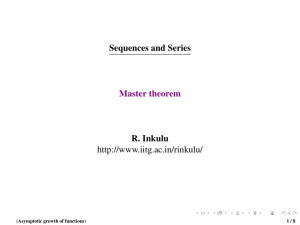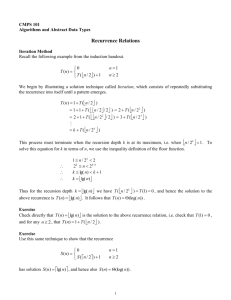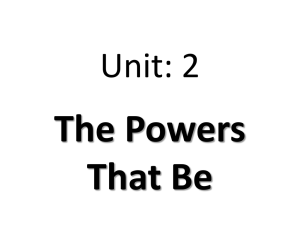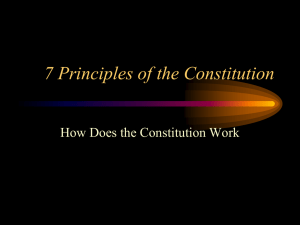The master theorem
advertisement
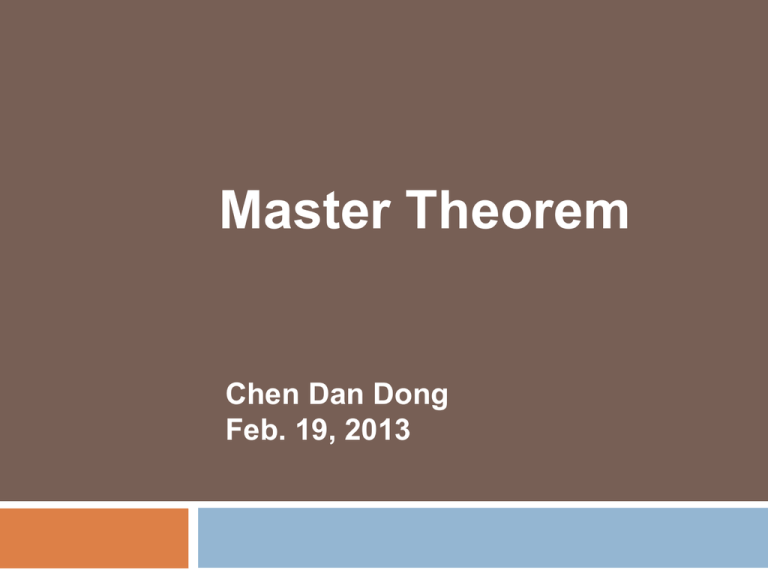
Master Theorem
Chen Dan Dong
Feb. 19, 2013
Outline
Review of asymptotic notations
Understand the Master Theorem
Prove the theorem
Examples and applications
Review of Asymptotic Notation
Θ notation: asymptotic tight bound
Θ(g(n)) = { f(n): there exist positive constants c1, c2,
and n0 such that 0 ≤ c1g(n) ≤ f(n) ≤ c2g(n) for all n ≥
n0}.
O notation: asymptotic upper bound
O(g(n)) = { f(n): there exist positive constants c, and
n0 such that 0≤ f(n) ≤ cg(n) for all n ≥ n0}.
Ω notation: asymptotic lower bound
Ω(g(n)) = { f(n): there exist positive constants c, and
n0 such that 0≤ cg(n) ≤ f(n) for all n ≥ n0}.
Review of Asymptotic Notation (Con.)
Asymptotic notation in equations
Theorem:
For any two functions f(n) and g(n), we have
f(n) = Θ(g(n))
if and only if f(n) = O(g(n)) and f(n) = Ω(g(n)).
Master Theorem
Theorem: Let a ≥ 1 and b > 1 be constants, let f(n) be a
function and let T(n) be defined on the nonnegative
integers by recurrence T(n) = aT(n/b) + f(n),
Then T(n) has the following asymptotic bounds.
Case 1. If
for some constant ϵ > 0,
then
Case 2. If
then
Case 3. If
for some constant ϵ > 0,
and if a f(n/b) ≤ c f(n) for some constant c < 1 and all
sufficiently large n, then T(n) = Θ(f(n)).
Proof of Master Theorem
The proof consists of two parts
The
first part analyzes the recurrence under the
simplifying assumption that T(n) is defined only on
exact powers of b, for n = 1, b, b2, ….
The second part extends the analysis to all
positive integers n with handling floors and
ceilings.
Due to time limit, I will only show the proof for
the first part for n as exact powers of b.
Proof – Lemma 1
Lemma 1. Let a ≥ 1 and b > 1 be constants,
let f(n) be a nonnegative function defined
on exact powers of b. Define T(n) exact
powers of b by the recurrence
where j is a positive integer. Then
Proof – Lemma 2
Lemma 2. Let a ≥ 1 and b > 1 be constants, let f(n) be a
nonnegative function defined on exact powers of b. A
function g(n) defined over exact power of b by
has the following asymptotic bounds:
Case 1. If
for some constant ϵ > 0,
then
Case 2. If
then
Case 3. if a f(n/b) ≤ c f(n) for some constant c < 1 and all
sufficiently large n, then g(n) = Θ(f(n)).
Combining Lemma 1 and Lemma 2
Lemma 3. Let a ≥ 1 and b > 1 be constants, let f(n) be a
nonnegative function defined on exact powers of b.
Define T(n) exact powers of b by the recurrence
Then T(n) has the following asymptotic bounds:
Case 1. If
for some constant ϵ > 0,
then
Case 2. If
then
Case 3. if
for some constant ϵ > 0,
and if a f(n/b) ≤ c f(n) for some constant c < 1 and all
sufficiently large n, then g(n) = Θ(f(n)).
If n is not exact powers of b…
If n is not exact powers of b, then n/b is an not
integer.
We need to obtain a lower bound on
T(n) = a T(⌈n/b⌉) + f(n)
and an upper bound on
T(n) = a T(⌊n/b⌋) + f(n).
If intersted, check out here.
Master Theorem
Theorem: Let a ≥ 1 and b > 1 be constants, let f(n) be a
function and let T(n) be defined on the nonnegative
integers by recurrence T(n) = aT(n/b) + f(n),
Then T(n) has the following asymptotic bounds.
Case 1. If
for some constant ϵ > 0,
then
Case 2. If
then
Case 3. If
for some constant ϵ > 0,
and if a f(n/b) ≤ c f(n) for some constant c < 1 and all
sufficiently large n, then T(n) = Θ(f(n)).
Some examples
T(n) = 9 T(n/3) + n
Case 1.
T(n) = T(2n/3) +1
Case 2.
T(n) = 2T(n/2) + n lgn
Can’t apply Master Theorem.
Binary Search
Binary search finds the position of a specified
value within a sorted array.
Finding the recurrence relationship
Applying Master Theorem.
Case 2. T(n) = O(lg n).
